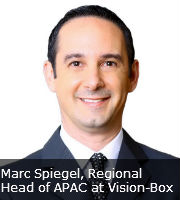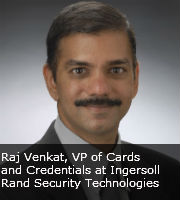Seeing the noninvasive, face-capturing benefits, different verticals are incorporating face recognition into their settings, acting as access control devices or identification tools. In each different setting, users must be perfectly aware of their environments and the dynamics surrounding it. Users need to know that there is no such thing as a one-size-fits-all solution. Each environment requires its own customized settings and calibrations in order to guarantee maximum accuracy and security.
Seeing the noninvasive, face-capturing benefits, different verticals are incorporating face recognition into their settings, acting as access control devices or identification tools. In each different setting, users must be perfectly aware of their environments and the dynamics surrounding it. Users need to know that there is no such thing as a one-size-fits-all solution. Each environment requires its own customized settings and calibrations in order to guarantee maximum accuracy and security.
Most of the time, a correct selection, planning, installation and configuration of the cameras in a given scenario drastically reduce the sources of failure, said Carles Fernández Tena, R&D Project Manager of Herta Security. Common failures are also caused by incorrectly operating the system, such as the wrong adjustments of  parameters and thresholds, or enrolling subjects with low-quality images. “In this regard, some sophisticated facial recognition systems currently incorporate automatic quality control modules and self-healing techniques to detect and rectify such misuses,” Fernández further explained.
parameters and thresholds, or enrolling subjects with low-quality images. “In this regard, some sophisticated facial recognition systems currently incorporate automatic quality control modules and self-healing techniques to detect and rectify such misuses,” Fernández further explained.
The biggest problems are related to the lack of knowledge from users which can create frustration and anxiety, turning what could be a quick process into a time-consuming task. “The use of graphic aids, including video animations, can drastically improve the overall experience,” said Marc Spiegel, Regional Head of APAC at Vision-Box.
 Matters of privacy can be an area of high concern for some users; this accentuates the importance of educating users on how biometric templates are stored, as they are often misled and think their data are open to theft. “Sometimes, users fear their biometric information will be stolen, but chances of that are unlikely because their raw data is actually configured to a digital code and saved in the database, instead of just the raw data,” asserted Raj Venkat, VP of Cards and Credentials at Ingersoll Rand Security Technologies.
Matters of privacy can be an area of high concern for some users; this accentuates the importance of educating users on how biometric templates are stored, as they are often misled and think their data are open to theft. “Sometimes, users fear their biometric information will be stolen, but chances of that are unlikely because their raw data is actually configured to a digital code and saved in the database, instead of just the raw data,” asserted Raj Venkat, VP of Cards and Credentials at Ingersoll Rand Security Technologies.
City Surveillance
Employing facial recognition alleviates the work load of operators by simply sending out an alarm once a wanted criminal or target has been identified from the crowd. India's safe city project intends to cover several of its cities extensively by surveillance systems that can recognize faces and detect wanted criminals or terrorists, and flag off a centralized control room. Other surveillance systems put up by the police, other agencies and third parties, such as hotels and retail multiplexes, will be integrated as “databases.”
Even though the Tsarnaev brothers, responsible for the Boston Marathon bombing, were actually in the FBI database, the facial recognition software failed to recognize the perpetrators due to the poor picture quality of their faces that were mostly angled away. With rising awareness and installations of HD cameras, facial recognition for similar situations in the future will prove to be much more successful.
Law enforcement agencies can further take advantage of mobile devices, such as handhelds or smartphones, performing recognition on-the-go to further facilitate accuracy improvements and calibrations.
Event Security
Large-scale, open events — often sports-related — are prone to terrorist attacks; employing the right level of security measures is crucial. The capacious area increases the difficulty for the human eye to make out specific targets among the sea of faces. By utilizing facial recognition, security guards will be able to locate those on the blacklist or VIP list at an accelerated rate.
The upcoming 2014 FIFA World Cup, scheduled to take place in Brazil, portrays the scenario perfectly. The country was determined to make the tournament “one of the most protected sports events in history,” shelling out US$900 million for the event. With the hefty fund, the country bought US military robots, Israeli-made drones, high-tech surveillance, and facial recognition glasses that can capture up to 400 images per second to be stored in a database of up to 13 million faces. The system is designed to match known criminals and terrorists. Currently, the guards are already being trained to properly operate these devices.
Airports and Border Control
Not only are facial biometrics used as part of the identifying process for national IDs and biometric passports, they are used in airports and border control as well. Now, biometric recognition is incorporated into solutions that are “designed to automate the secure and fast flow of passengers through restricted areas such as security and border checkpoints,” said Jim Slevin, Aviation Business Unit Manager at Human Recognition Systems (HRS). Recently, HRS deployed its system at Edinburgh Airport to assess the flow of passenger traffic through its security screening area to help address the bottleneck queues, though it was initially used as a performance measurement tool that anonymously measures how long people spend in queues and dwell areas of the airport.
“The same solutions when designed sympathetically can offer benefits for both security and passenger differentiation — the ability to identify and tailor journeys on an individual traveler basis,” Slevin added. Facial biometrics are used in airports to facilitate the passenger's check-in to departure experience. After recognizing passengers who are enrolled in the service, texts will be sent to the passenger and guide them through the process of self check-in and baggage drop-off, all the way until the passenger arrives at the correct departure terminal and goes through the gates. Enrolled passengers are often frequent flyers who are offered this opportunity as a part of the perks, in a sense, treated like VIPs by being able to avoid long wait time.
Other e-gates allow for integrated or a combination of facial, fingerprint and iris recognition, and can be used at any country entry/exit point, Spiegel added.
Retail, Banking and Gaming
Operators will be able to analyze their customers based on their facial expression. Retailers will be able to register and create a watch list for shoplifters or VIPs. Shoplifters will be immediately escorted out of the stores when they are identified, while VIPs will be treated with the greatest shopping experience that can be provided. “As soon as you walk into Macy's and get to a certain area, they already know what you like and your buying preferences. I think there will be a lot of great technologies introduced in the next five years!” said Mizan Rahman, founder and CEO of M2SYS.
Banks will be able to use facial recognition for identifying criminals in order to prevent robberies. Customers can also be identified for better services and accessing ATMs and safety deposit boxes. As for online transactions, Facebanx has developed a new online facial recognition solution that will enable banks, payment processors, and insurance and ID verification companies to dramatically reduce fraud and ID theft. Users simply need to add their face to their account via the camera from their electronic device, such as a mobile phone or laptop webcam. Each individual's face is recorded by a video stream (rather than stills), and the technology compares the multiple images taken throughout the recording to confirm the person is real and not a spoof by a photo.
In the gaming sector, a few years back, certain Canadian and Singaporean casinos started to use facial recognition to track down and identify gamblers who have put themselves on a self-exclusion list. The facial recognition software instantly scans photographs taken by a dedicated camera as visitors pass by a security desk, looking for matches with pictures of gamblers who have put themselves on the self-exclusion list. If a match is found, a silent alarm goes off, the matching photos pop up on a computer screen, and security guards compare them. Once the guard verifies the match between the visitor and the image on the screen, they will ask for the identification of the individual before escorting him or her from the facility. For those who have not been placed on the list, their photographs are instantly discarded. The cameras with facial recognition are also used for identifying VIPs, cheaters, as well as authorized personnel in the cashiers and vaults.
Automobiles
Facial recognition for automobiles has been heavily researched and tested so it can be incorporated into onboard cameras in order to track the driver's pupils and facial orientation to detect head movement, eye direction and blinking patterns. If the system senses the driver is about to fall asleep, it will issue an alert for drivers to pull over to the side of the road. For driver convenience, BMWs use facial recognition to adjust to each driver's customized settings, such as steering wheel height, seat position, mirrors, and even turn on his or her favorite radio station. However, there are some problems to tackle, such as where to best position the camera to capture the face again immediately after being obstructed by the driver's hands and steering wheel. Adapting to changing lighting conditions is no small feat either, since cameras have to be able to continuously capture the driver's face even as she drives through a tunnel, into the sunset or after dark.